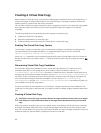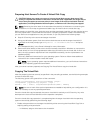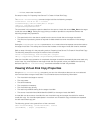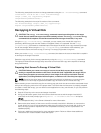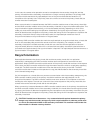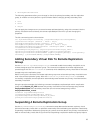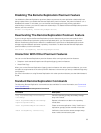
primary (local) and secondary (remote) virtual disk pairs, called replicated pairs, write operations to the
primary virtual disk of the pair are tracked by the RAID controller firmware and captured in a point-in-
time image and transferred to the secondary virtual disk in the pair.
Remote Replication groups allow you to manage synchronization of both virtual disks to create a
consistent data set across local and remote storage arrays. Point-in-time images on the primary virtual
disk and the secondary virtual disk can be resynchronized in a batch approach that increases replication
throughput. When data synchronization completes, the system uses the point-in-time images on the
secondary virtual disk to ensure that the data is maintained in a consistent state during subsequent
synchronization operations to the secondary virtual disk.
Replication Pairs And Replication Repositories
Replicated pairs, comprising of a primary and secondary virtual disk, contain identical data copies as a
result of data synchronization. Replication repository virtual disks are used to manage replication data
synchronization and are required for both the primary virtual disk and secondary virtual disk in a
replicated pair.
A replication repository consists of the following data:
• Resynchronization and recovery point images for primary and secondary virtual disks.
• Tracking data from the primary virtual disk that occurs in between synchronization intervals. This data
is also written to the secondary virtual disk in case a reversal of the primary/secondary virtual disk role
should occur.
Differences Between Remote Replication And Remote
Replication (Legacy) Features
The standard Remote Replication premium feature uses a point-in-time snapshot image to capture the
state of the source virtual disk and only writes data that has changed since the last point-in-time image.
The Remote Replication (Legacy) premium feature reproduces every data write to the local (primary)
virtual disk on the remote (secondary) virtual disk through a Fibre Channel-only connected configuration.
While not producing a fully synchronized data view between both storage arrays, standard Remote
Replication offers a much faster replication solution that can run on both iSCSI and Fibre Channel
configurations.
NOTE: Both remote and local storage arrays must of the same data protocol. Replication between
Fibre Channel and iSCSI storage arrays is not supported.
Standard Remote Replication creates a repository virtual disk for each replicated pair, increasing
throughput between local and remote arrays. Remote Replication (Legacy) uses a single repository virtual
disk for all replicated pairs.
Physical distance between local and remote storage arrays is unlimited using the Standard Remote
Replication premium feature. Remote Replication (legacy) is limited to approximately 10 Km (6.2 miles)
between local and remote storage arrays.
Link Interruptions Or Secondary Virtual Disk Errors
When processing write requests, the primary RAID controller module might be able to write to the
primary virtual disk, but a link interruption might prevent communication with the remote (secondary)
RAID controller module.
88



